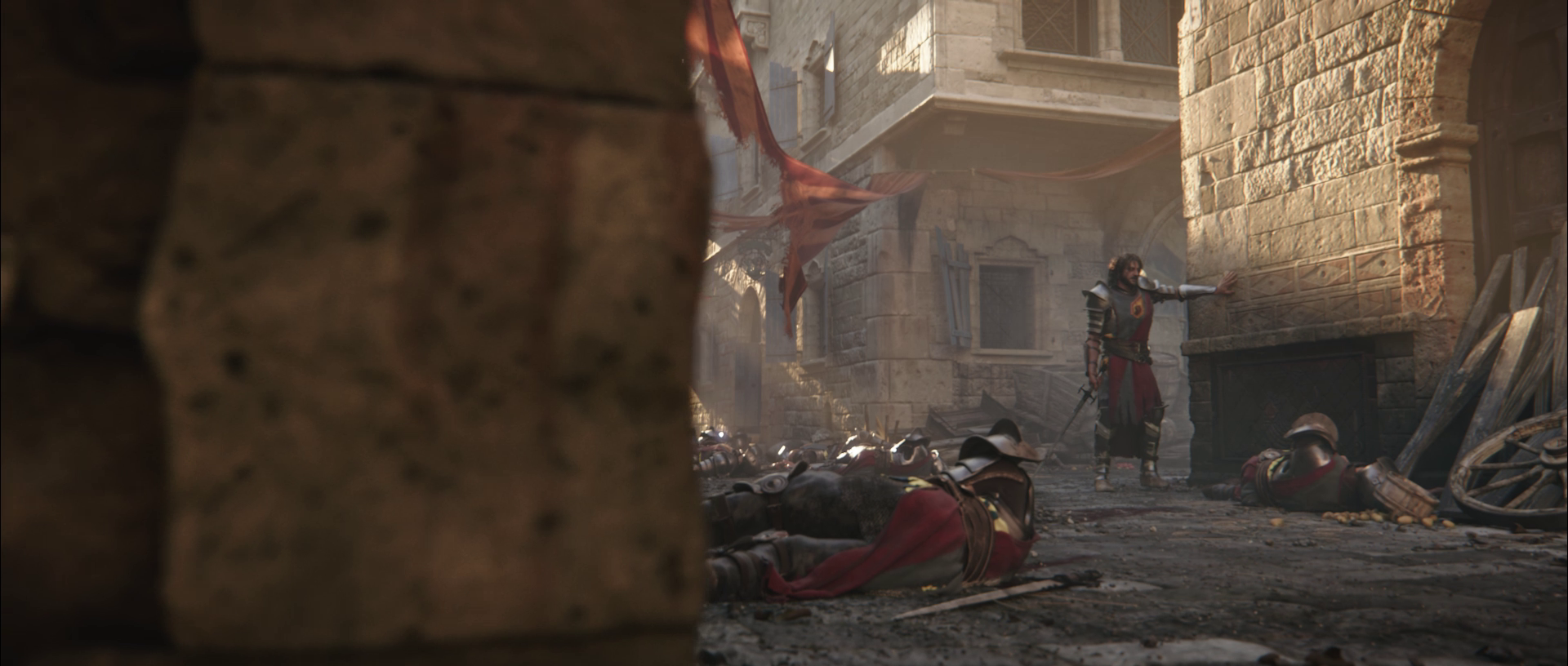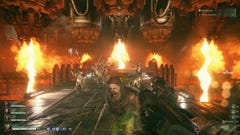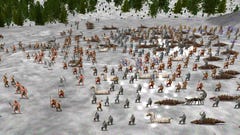Baldur's Gate 3 announced, from the creators of Divinity: Original Sin
"We're building a rollercoaster!"
They call it Ceremorphosis. The excruciating seven day process by which a humanoid might transform into a Mind Flayer. Stick one illithid tadpole in the brain and one week later you’ve got an octopus for a head and a craving for more grey matter. And what better visual metaphor for the return of Baldur’s Gate: the adventure that lodged in the hearts and minds of every RPG fan of a certain age, until it could find a host capable of doing it justice. The search took 20 years. That body belongs to Larian Studios. The game is Baldur's Gate 3.
Before we chat specifics: that reveal! Blimey. Ceremorphosis might be the inspiration, but when crafting a 90 second teaser trailer you’ve got step on the gas a bit, so the process is accelerated. A week of suffering becomes a frankly horrendous slice of Cronenbergian body-shattering that is so gnarly the uncut version of the teaser was not shown at today's Stadia announcement. I know Google want us to give their streaming tech a thumbs up, but not when that thumb is being snapped 90 degrees by a mind maggot. I direct your eyes to Larian’s full version below...
The trailer offers the only firm details of Baldur’s Gate 3’s setting we’re getting for now. We see the city of Baldur’s Gate, obviously - the mist-shrouded jewel of the Sword Coast, where the rich perch on the hills above and things get danker as you travel down to the sea. You’ll spy the sigil of the Flaming Fist on our unsuspecting victim; these are the mercenaries who police the city. That is, when they aren’t exploding from the inside out.
Larian studio head Swen Vincke says other easter eggs are there to be found, but does draw our attention to the skies at the end of the trailer. “The big tentacle thing is called a Nautiloid - it’s how the Mind Flayers traverse the astral plane. It was made popular in a [D&D] sub-universe called Spelljammer, but we just thought it was incredibly awesome. This is going to be biggest Nautiloid you’ve ever seen.”
To many, it might be the first Nautiloid they’ve ever seen. Frighteningly, to some, it might be the first Baldur’s Gate they’ve ever seen. It’s been over 20 years since the Bhaalspawn set out to settle the daddy issue to end all daddy issues, and almost 20 years since BioWare wrapped that quest up in Throne of Bhaal. As I see the logo appear in the teaser - that combination of words I didn’t ever expect to see again - I wonder what Baldur’s Gate even means in 2019. I guess the crucial question is what it means to Larian. What do they see as the defining factors any worthy successor would have to capture?
“Baldur’s Gate added a few things to the state of the art back in 1998,” says Vincke. “The party became much more important, there were the relationships between the party - much more in Baldur’s Gate 2 than one. And it was a game that had an insane amount of exploration, so there was a big world to explore. And everywhere you went there was always story to experience; always stuff to discover, people to talk to, interactions to be had. And it felt that you made decisions that affected the world. That was one of the big things that it brought to role-playing games as a genre. It was also one of the very first RPGs to offer multiplayer when playing a story - it was primitive, but it was one of the first ones to do it.”
And all this is true of Baldur’s Gate 3? “Yeah. The party's going to be big, exploration’s going to be big, player agency is going to be big, decisions are going to be big, multiplayer is going to be big - and single player, obviously. The originals were also tough games, so challenges are going to be big.”
If you’ve played Larian’s Divinity: Original Sin you’ll know all this can be said of those games, too. Baldur’s Gate was based on a modified version of the Advanced Dungeons & Dragons rulebook, and Larian is a studio partially born from a passion for D&D. Several campaigns run continuously in the office, and Vincke has long turned to the player handbooks and monster manuals for inspiration. “The thing Wizards Of The Coast is incredibly good at is making idea generators,” he says. “When you read a campaign, you get plenty of ideas that you roll with and create your own adventures.”
Whether intentionally, or by years of cultural osmosis, the adventures Larian make have similar game systems to D&D. As Vincke describes it: “[D&D] gives you a hook, an adventure, that you start on, and they give you a role - the character that you typically created - and they give you a system and with that system you overcome challenges thrown at you by the Game Master. And the Game Master comes up with these crazy challenges and if he or she is good, then those challenges will be just what you can manage with the systems that are at your disposal at that moment. And that’s pretty much what we do. That’s the form of a Divinity: Original Sin game: we give you freedom, player agency, plenty of ways of glitching the system, then we throw a challenge at you that feels impossible then you figure it out and you feel good about it. It’s literally the same format. The match is very natural.”
So the question becomes, how will Baldur’s Gate 3 differ from a theoretical Original Sin 3? Some of what Vincke describes does sound like natural sequel territory. “There’s only so many things we can do when making one game and so by the time we finished with Original Sin 2 there was already a shitload of ideas of things we wanted for the next game and so they will be implemented in Baldur’s Gate 3.”
He promises “a whole bunch of new systems” but won’t name them, pointing us to the 5th edition D&D rulebook for inspiration. “We have carte blanche and can take whatever we want. They have cool systems they’ve developed over time. When you play it you’ll start to figure out that there are many more systems than Original Sin 2 had. You can fool around and say ‘if I do this and this and this… ha! It worked!’ You’ll get that feeling.”
That shift to modern D&D rules is the biggest clue we get as to how the game will play. It means saying goodbye to the Infinity Engine, for starters. “Those were great games for their time, but next year is 2020 and you can’t do the same things you did back then. No one would want to play it. Well, people would want to play it, but it wouldn’t meet the expectations of a modern video game” says Vincke.
This also means farewell to the wonky THAC0, the archaic rule that somehow rewarded lower armour ratings and proves a baffling hurdle to diving into the older games today. Throughout our chat Vincke often mentions evolution and a refusal to take Larian backwards. “You’ll still find a game based on Forgotten Realms and the systems that are there, but is also based on what videogames have done in CRPGs up until now. I hope it’ll further the state of the art.”
Let’s attempt to mine some specifics. When I think of Baldur’s Gate, it’s the tale of a hero and the companions who rallied around them. Original Sin’s big contribution to the genre is a party of protagonists, all capable of pushing story in new directions. And in Baldur’s Gate 3? “Everybody’s going to be a hero, but it’s a party of heroes that comes together. Together they will be able to overcome, isolated they may not be able to manage to do it as well as they could if they worked together.”
And what of the fragility of that cast? Baldur’s Gate had a large companion count, but happily chewed them up with perma-death. Sounds like you best get practicing your eulogies this time, too. “The thing about player agency and making tough decisions is that if it goes badly it should go badly. We’re going to be following that recipe, yes.” And while you’ll still have to pick your character's moral alignment, “In 5th edition [rules] the impact of alignment is a bit lesser than it used to be in 2nd edition. So that will be less.”
There’s also a question of world design. Baldur’s Gate 1 and 2 were different games in this regard; the former sprawling, the latter opting for tighter areas, crammed with story - such as Athkatla, where heroes were challenged to raise a sum of money and given a city packed with side quests to achieve it. Vincke believes the two don’t have to exclude each other, that Original Sin already boasts density in a quest that hardly feels small. “We’re making a rollercoaster - there’s going to be a lot of stuff happening, but it’s going to be dense,” he says. “It has to be dense in our gameplay formula because we don’t know how you’re going to arrive as a party, we don’t know what skills and abilities you’re going to have. Can you speak to animals or not? Because if you can, it’s a useless mechanic if there’s no world to serve it. So we have to serve it - and trust me, we have a lot of mechanics. We have to make a world that serves them and as a result it’s bound to be dense.”
With that density comes a fearlessness to allow some of it to fall by the wayside. It was possible - intentional, perhaps - to miss heaps of adventuring in Baldur’s Gate 2. Spare a thought for the poor souls who hopped in a magic portal and teleported past an entire jaunt to a kingdom of shark people. Tragic! Vincke says “we’re not afraid of culling a whole bunch of content based on decisions you make. It’s the only way you can have decision making that feels real as you have to have stuff that can go away.”
Original Sin 2 was Missable Side Quests: The Game, and Vincke suggests the stakes will be higher in BG3. “I’m thinking of a cool example - you can rest assured it’ll be one of my first press demos in the game, just to show how this is what happens because of that. You’re going to say ‘are you insane?’ because there’s so much stuff we’re going to cut right there.”
The story itself will not be a direct continuation of events from the original game. “The story of the previous Baldur’s Gate was closed - it was actually closed, in a certain sense, in a tapletop campaign called Murder At Baldur’s Gate [where the murder of the original protagnoist triggers the action - ed], so that’s where it really came to its closure,” says Vincke.
What he can tell me is that “we are in the city of Baldur’s Gate, we’re in Forgotten Realms and stuff has happened in the world since [D&D’s] 3.5 edition. This game directly follows a new campaign called Baldur’s Gate: Descent Into Avernus, we worked very closely with them on that, and so our story continues right after that.” This makes talking about the game even more challenging, as Ascent Into Avernus isn’t out until September and Vincke doesn’t want to spoil how that story unfolds.
It does sound like we’ll be able to look at that campaign and get a clue or two about Baldur’s Gate 3’s new ideas. Vinke paints a picture of Larian and Wizards working closely to support each other’s vision, to the point where “they came up with something in [the Avernus] campaign that we thought was so cool we dropped what we were doing on one bit and changed it to theirs, because it was too cool.” Considering that Avernus is described as ‘Mad Max in hell’ and introduces rideable war machines into the mix, I know which idea I hope it is. (I’d also settle for D&D’s new ‘Devil Deals’, which will let you barter with infernal creatures for just about anything, should you be willing to risk the duplicitous small print.)
Of course, it’s not essential you play the tabletop campaign to prep for BG3. Vincke says “If you have played it, when you play Baldur’s Gate 3 - literally in the opening area you’ll be like ’oh my god, that’s linked to this and that’s linked to that’. You’ll understand what’s happening.” And if you haven’t? “You’ll still understand, but you won’t get the history of it.”
This leads to a bigger question about general accessibility - if you come to the original games now, it’s very easy to bounce of the idiosyncrasies of simulated D&D systems. Vincke reassures us that “5th edition [D&D rules] is very different to 2nd Edition already, so it is much more accessible -- this is also why it's enjoying an increased popularity. So the videogame will be similar. We’re not going to compromise on depth, but the way it’s going to be brought to you, when you see it you’ll think ‘I get this, everyone can get this’.”

Speaking of the ‘everyone’ - one of the driving factors of Larian’s partnership with Google’s streaming platform Stadia is the desire to see Baldur’s Gate 3 in as many hands as possible. Vincke acknowledged “there’s a lot of scepticism in the PC industry about it” but believes “it’s a very democratic platform in the sense that if you have a shitty PC you’ll still be able to play at high specs - and for someone who makes multiplayer RPGs that take hundreds of hours to complete and allow a group to play together, this is the perfect fit for it.” The big barrier to entry to enjoying a four-person campaign in Original Sin 2 is getting four pals in front of a PC for hours at a time. But, as Vincke puts it, with Stadia “it’s just a link - I send you a link and you’re playing immediately. So if I’m playing in multiplayer and you want to try it out with me, I just send you a link, we join up and we’re playing.”
He’s also enthusiastic about the community features that become available when “things become server-based for games like this. Because everything is present [on the server], interactions that otherwise wouldn’t be possible are possible.” Of course, until Google announce those features themselves, we can only speculate. Perhaps by the time you read this we’ll have a better idea. And for the sceptics out there, this doesn’t mean the PC version is inferior. “There are a couple of community things that I wouldn’t know how we would do them on PC, so that’s the big differentiator,” says Vincke.
Otherwise, it means more people get to enjoy a more lavish game. A team of almost 300 means “production values are high and high production values means high GPU and so forth. We’re trying to bring min specs as low as we can but there are limits to what we can do - there are a couple of features that require CPU power” - come on infernal war machines - “and this is going to be another way of accessing it if you can’t.”
For the lack of concrete details Vincke can share on those CPU-pushing features - and indeed, most of Baldur’s Gate 3 - there’s a confidence in him, and others at Larian that we meet, that this is going to be a big step forward for the studio, and the genre. Considering their confidence, and the existence of their own, popular fantasy universe, I wonder aloud why they even need a 20-year-old licence for their next game.
“You should see the reaction of team when I said Baldur’s Gate 3,” says Vincke. “I never have to motivate them again!” Though he admits that younger staff are less familiar - “that was eye-opening” - he describes the original’s reputation as the great motivator. “People have been waiting for this game for almost 20 years, so it’s the type of challenge to rally a team around. Can we do this? There’s plenty of opportunities to fuck it up. We’ll try not to. We’ll try to over-deliver on it, so people will say ’okay, this is a genuine successor to one of the most influential RPGs ever made’.”
Disclosure: Adam Smith, formerly RPS's deputy editor, is now a writer for Larian. If you just dry heaved at the bloody sight of Ceremorphosis, he probably had something to do with that. A dark individual, was Adam.









